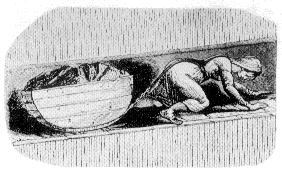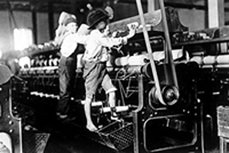North Carolina War Between the States Sesquicentennial
The North's Industrial Revolution Labor System

New England sold its slaves southward while developing a new factory labor system more
efficient and practical. For workers at the Lowell, Massachusetts mill it was reported that “there is no privacy,
no retirements here; it is almost impossible to read or write alone.” Another contemporary hinted that
some of the girls eventually moved from mill work into prostitution; and few of the mill girls would
return to their native towns with reputations unimpaired. That “she has worked in a factory” was
almost enough to damn to infamy the most worthy and virtuous girl.”
New England Wage Slaves
“Chapter XII: In Which is Explained Why Yankees Discarded Negro Chattel Slavery and
Recalled the Plight of the White Wage Slaves and a Comment by Abraham Lincoln.
Negro slavery was a flop in the North.
The accent up there was on manufacturing and the Negro was at his best when teamed up with
a hoe and a cotton-patch. The thrifty manufacturers of New England had a cheaper and more
efficient labor supply readily at hand in the white wage slaves already there and the
immigrants from Europe who came flooding in.
A healthy Negro field hand in 1860 cost $1,000 in Virginia and as much as $1,500 in New Orleans.
A new-born slave baby was worth $200. The chattel slave had to be fed and clothed and taken
care of in sickness and in health. When he got too old to work he had to be provided for.
Some States made it illegal for slaves to be worked on Sundays under pain of a fine of five pounds.
It was against the law to work a slave more than fifteen hours a day in the summer and fourteen
hours a day in winter. The average work day was about eleven hours. The slave was given a
holiday between Christmas and New Year’s. Louisiana prescribed by law that every slave
had be given a minimum of 200 pounds of pork a year.
The New England white wage slave wasn’t nearly as expensive and a lot more efficient. He represented
no capital outlay. He worked for starvation wages. Laborers in the North in 1860 were earning 60 cents
a day, and a day was often 14 to 16 hours.
The plight of women workers was even more appalling. In New York City, during the Civil War,
women umbrella workers, after laboring 18 hours from six in the morning to midnight, earned
three dollars a week. Seamstresses in the underwear crafts got seventeen cents for a twelve-hour day.
When the wage-slave got sick he went off the pay-roll. When worn out by age and hard work,
he [or she] was discarded like an old shoe.
Bells rang at daybreak in most factory towns. The wage slaves – men and women – had to report
at the factory gates in fifteen minutes. An hour later they were allowed twenty-five minutes for
whatever breakfast they had brought. They got another twenty-five minutes at mid-day. The gates
opened again at 8 o’clock that night to let the wage slaves go home.
In the Eagle Mill at Griswold, [Connecticut], the work day lasted fifteen hours and ten minutes.
At Paterson, New Jersey, women and children began the day’s work at 4:30 o’clock in the morning.
Overseers in some textile mills cracked a cowhide whip over the backs of women and children.
That isn’t to say that chattel slavery was to be preferred to wage slavery. There were folks who used
to say that back in the middle of the past century but whenever Abraham Lincoln heard them Old Abe
would sort of hunch those bony shoulders of his and cock his head to one side and burn
them down with a single sentence.
“They’ve written volume after volume to prove slavery a good thing,” he’d say, “but I never heard
of a man who wishes to take the good of it by being a slave himself.”
(Then My Old Kentucky Home, Good Night!, Debnam, The Graphic Press, pp. 30-32)
Not only did Eli Whitney’s invention revolutionize the labor-intensive cultivation of cotton,
but Massachusetts textile mill owner Francis Cabot Lowell’s vision of extreme wealth and
financial empire fueled the need for African slave labor to till Southern plantations essential
to his industry. Karl Marx observed in 1846, “Without slavery there would be no cotton,
without cotton there would be no modern industry,” and he saw clearly who and what was
perpetuating African slavery in the United States.

The Cotton Was in the South, the Action Was in the North:
“The explosion of raw material from the South that followed [Eli Whitney’s invention] soon
enriched New England’s textile aristocracy whose mills were partially responsible for driving
up the number of slaves fivefold between 1800 and 1860. In that year close to four million
slaves accounted for nearly 40 percent of the South’s population. Seeking new arable
cotton acreage, Southern growers by then had relentlessly expanded westward into
virgin territories that would become Texas, Louisiana, Oklahoma and Missouri.
In the Treaty of Ghent, which ended the War of 1812, England and the United States agreed
to suppress the slave trade. So much for policy positions. In reality, Baltimore builders designed
faster clipper ships to carry and deliver cargoes of slaves for Liverpool’s thriving slave traders.
Slave-produced cotton created many of England’s most prestigious banks, including the giants
Barclay and Lloyds. Liverpool’s towering skyline of massive Victorian commercial buildings
stands as a monument to [slave-produced] cotton supremacy.
[New England] cotton mills were well on their way to producing $115,000,000 worth of cotton
by 1860, or three times as much as the country imported, and every ounce of it relied wholly
on slave labor. A US Census in 1790 counted nearly 697,124 slaves, with almost as many in New York
(21,234) as in Georgia (29,264). Despite the Constitutional ban on further importation in 1808,
by 1820 there were 1,533,086 slaves, almost all now in the South, and Virginia alone accounted
for 425,757. By then the South produced an astonishing 2.275 billion pounds of raw cotton,
and the crop accounted for 60 percent of the country’s exports. The South now supplied over
80 percent of the cotton manufactured in Britain, two-thirds of the world’s total supply,
and all the cotton used in New England’s mills.
Cotton was New York’s leading export; the South depended on New York as well as for
European home furnishings and high-quality imported fabrics including silks and linens. The irony
in all this was that although a New York stopover required ships to travel 200 miles out of their
direct lane between Liverpool and Charleston, Savannah and New Orleans, there was no
logistical reason for its involvement. “The combined income from interest, commissions,
freight, insurance, and other profits were so great that, when Southerners finally awoke to
what was happening, they claimed that New Yorkers with a few other Northerners were
getting forty cents for every dollar paid for Southern cotton,” one historian reported.
Southern States that had fought to win their independence from the British crown now
relinquished it economically to the North.
New York did more than ship Southern cotton; it provided much of the funding for it.
Hundreds of Yankee cotton factors from New York blanketed the South every year, working with
Manhattan banking houses that had the capital to make loans. Acting as independent intermediaries,
the factors advanced long credit at high interest against next year’s crop, usually from
7 to 12 percent, and took their cut. Southern banks played a minor role. [Planter] Debt was chronic.
It resulted primarily from the growers’ need to expand their acreage and buy more slaves. That in turn
gave financiers from England and New York the power to monitor their operations, squeeze out
higher interest rates…bales became payment; they quickly turned into cash as New Yorkers sold
that raw cotton to Liverpool to supply Lancashire’s mills. The cotton fields were in the South,
but the action was in the North for speculators and businessmen.”
(Cotton, Stephen Yafa, Penguin Books, 2005, excerpts pp. 121-136)

Then My Old Kentucky Home, Good Night!, W.E. Debnam, The Graphic Press, 1955
Cotton, Stephen Yafa, Penguin Books, 2005
Copyright 2013, The North Carolina War Between the States Sesquicentennial Commission